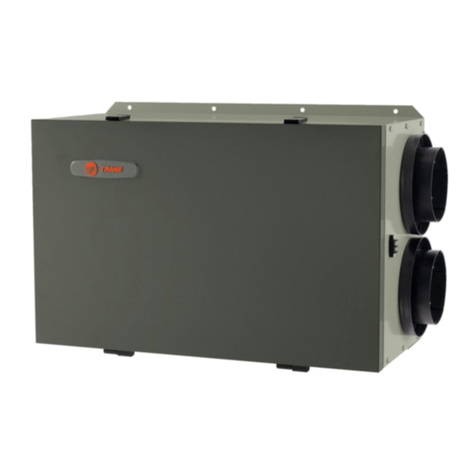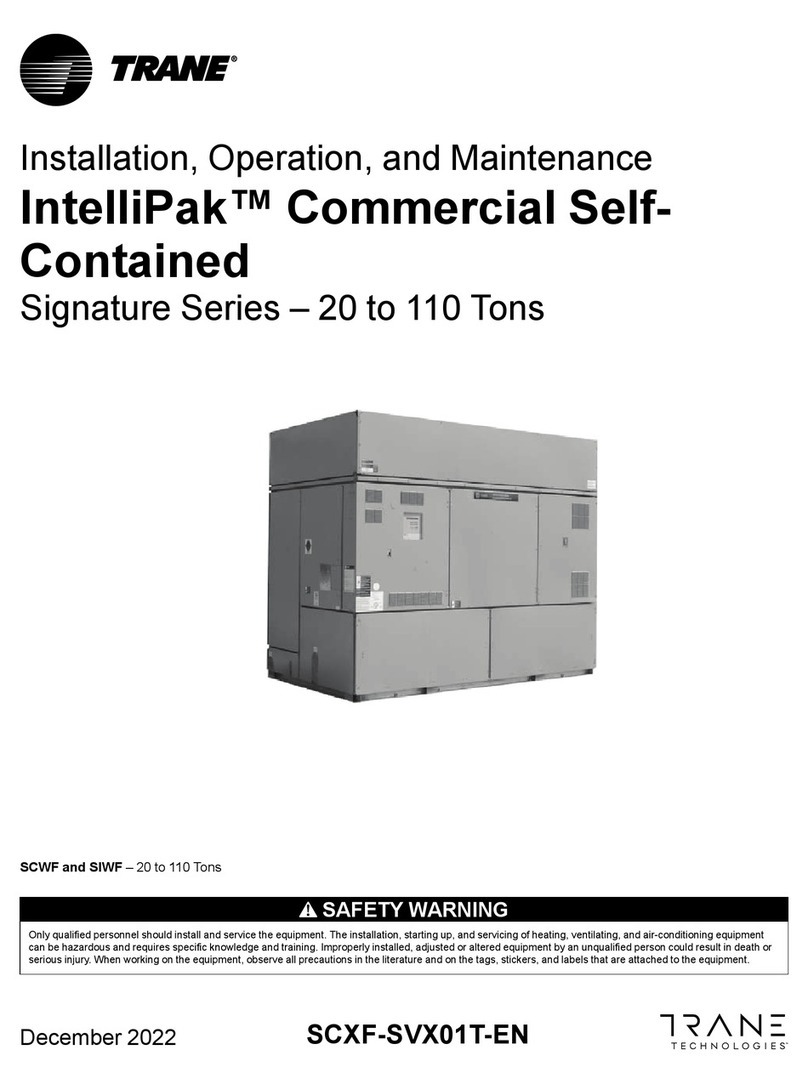
UV-SVX004E-EN 7
Model Number Description
Digit 1, 2, 3 — Unit Configuration
HUV= Horizontal Unit Ventilator
Digit 4 — Development Sequence
C = Third generation
Digit 5, 6, 7 — Capacity; Nominal
075 = 750 CFM
100 = 1000 CFM
125 = 1250 CFM
150 = 1500 CFM
200 = 2000 CFM
Digit 8 — Voltage (Volt/Hz/Phase)
1 = 120V/60/1
2 = 208V/60/1
3 = 208V/60/3
4 = 240V/60/1
5 = 240V/60/3
6 = 277V/60/1
8 = 480V/60/3-phase 4-wire power
supply
Digit 9 — Motor
0 = Free discharge ECM
7 = Free discharge ECM, low FLA
A = High static ECM
H = High static ECM, low FLA
Digit 10, 11 — Design Sequence
** = Design sequence
Digit 12, 13 — Coil Letter
Designation
(Single Coil Options)
AA = 2-row, 12 fpi chilled-water/
hot- water changeover
AB = 2-row, 16 fpi chilled-water/
hot-water changeover
AC = 3-row, 12 fpi chilled-water/
hot-water changeover
AD = 4-row, 12 fpi chilled-water/
hot-water changeover
AE = 4-row, 16 fpi chilled-water/
hot-water changeover
H1 = 1-row, 12 fpi heating coil
H2 = 1-row, 14 fpi heating coil
H3 = 1-row, 16 fpi heating coil
H4 = 2-row, 12 fpi heating coil
H5 = 2-row, 14 fpi heating coil
H6 = 2-row, 16 fpi heating coil
K1 = 1-row low capacity steam coil
K2 = 1-row high capacity steam coil
G0 = 2-row, 12 fpi DX coil
(Coupled Coil Options)
DA = 1-row, 12 fpi hot-water coil with
2-row,12 fpi chilled-water coil
DC = 1-row, 12 fpi hot-water coil with
2-row, 14 fpi chilled-water coil
DD = 1-row, 12 fpi hot-water coil with
3-row, 12 fpi chilled-water coil
DE = 1-row, 14 fpi hot-water coil with
3-row, 14 fpi chilled-water coil
DK = 1-row steam coil with 3-row
chilled-water coil
X3 = 3-element electric coil with
3-row chilled-water coil
(2-row on size 125)
GK = 1-row steam coil with 2-row
DX coil
GA = 1-row heating coil with 2-row
DX coil
G3 = 3-element electric heat coil with
2-row DX coil
R1 = 3-row, 12 fpi chilled-water coil
with 1-row, 12 fpi hot-water coil
R2 = 3-row, 14 fpi chilled-water coil
with 1-row, 12 fpi hot-water coil
Digit 14 — Coil Connections
A = Right-hand supply
B = Left-hand supply
C = 2 coil LH cooling/RH heating
D = 2 coil RH cooling/LH heating
Digit 15 — Control Types
A = Tracer® UC400-B
B = Tracer® UC400-B with time clock
C = Tracer® UC400-B with Air-Fi®
Wireless Communications
Interface (WCI)
E = Symbio™ 400-B
F = Symbio™ 400-B with time clock
G = Symbio™ 400-B with Air-Fi®
Wireless Communications Interface
(WCI)
N = CSTI fan status
P = Thermostat
Q = Tracer® ZN520
T = Tracer® ZN520 with time clock
X = Tracer® ZN520 with fan status
8 = Customer-supplied terminal
interface (CSTI)
9 = CSTI with low temp
Digit 16 — Face-and-Bypass/
Electric Heat Stages
0=None
1 = Face-and-bypass damper - field
installed actuator
8 = Face-and-bypass damper -
factory installed actuator
4 = Single-stage electric heat control
5 = Dual-stage electric heat control
Digit 17 — Future Option
0=None
Digit 18 — Damper Configuration
0 = Field-installed damper actuator
1 = 100% return air/no damper or
actuator
(Modulating ASHRAE Cycle II)
F = Return air/outside air damper
and actuator (2–10 Vdc)
A = Return air/outside air damper
and actuator (3-point
modulating)
E = Return air/outside air damper
and actuator with exhaust (3-
point modulating)
(Two Position Control)
D = Damper with manual quad
adjustment
Digit 19 — Zone Sensor/Fan Speed
Switch
0 = No sensor - unit-mounted fan
speed switch (CSTI)
A = Wall-mounted
J = Wall-mounted zone sensor
(OALMH; setpoint dial;
OCC/UNOCC
K = Wall-mounted zone sensor
(OALMH; setpoint dial)
L = Unit-mounted zone sensor
(OALMH; setpoint dial)
M = Wall-mounted display sensor
with setpoint adjustment
P = Wall-mounted sensor
(setpoint dial; OCC/UNOCC
with unit mounted speed switch
Q = Wall-mounted sensor
(setpoint dial) with unit
speed switch
3 = Wireless display sensor
(OALMH)
4 = Wireless sensor - ext adjustment
5 = Unit-mounted variable fan speed
control (CSTI)
Digit 20 — Inlet Arrangement
A = Fresh air (FA) duct top/return air
(RA) duct lower back
B = Fresh air duct top/return air duct
bottom
C = Fresh air duct top/return air bar
grille bottom
F = Fresh air duct upper back/return
air duct lower back
G = Fresh air duct upper back/return
air duct bottom
H = Fresh air duct upper back/return
air bar grille bottom
J = Fresh air duct upper back/return
air open bottom
K = 100% fresh air duct upper back
L = 100% return air duct lower back
M = 100% return air duct bottom
N = 100% return air bar grille bottom
P = 100% return air open bottom





























